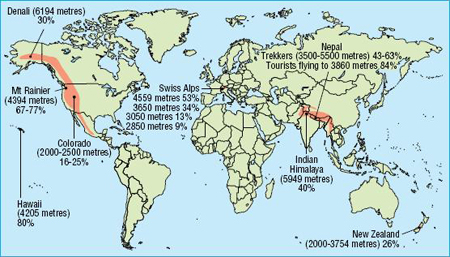Summary
Definition
History and exam
Key diagnostic factors
- headache
- ataxia
- change in mental state: for example, tired, irritable, confused, forgetful, irrational
- abnormal tone, power, and reflexes
Other diagnostic factors
- nausea, vomiting, and loss of appetite
- fatigue and weakness
- dizziness or lightheadedness
- difficulty sleeping
- visual disturbance
- shortness of breath
- cough with or without sputum
- rales
- peripheral edema
- accentuated pulmonary second sound
- pyrexia
- elevated respiratory rate
- elevated heart rate
- low arterial oxygen saturation
- cyanosis
- urinary incontinence or retention
- retinal hemorrhages and papilledema on fundoscopy
- chest pain
- cranial nerve palsies (III, IV, and VI)
- visual and auditory hallucinations, seizures, tinnitus, vertigo, tremors, speech disturbance, and deafness
Risk factors
- high altitude
- rapid ascent
- low-altitude residence
- history of previous altitude illness
- younger age
- exertion
- poor awareness of high-altitude illness prior to travel
- existing medical condition
Diagnostic tests
1st tests to order
- clinical diagnosis
Tests to consider
- arterial blood gases
- chest radiography
- ECG
- chest ultrasound and echocardiography
- WBC count
- lumbar puncture
- CT head
- MRI head
Treatment algorithm
high-altitude ascent planned
AMS
HAPE only
HACE only
concurrent HAPE and HACE
Contributors
Authors
Jeremy S. Windsor, MBChB, DCH, FCARCSI
Specialist Registrar
Anaesthetics and Intensive Care Medicine
University College Hospital
London
UK
Disclosures
JSW is an author of a number of references cited in this topic.
Peer reviewers
James S. Milledge, MBBS
Honorary Professor
Department of Physiology
University College London
London
UK
Disclosures
JSM declares that he has no competing interests.
Mike Grocott, MD
Senior Lecturer
Intensive Care Medicine
University College Hospital
London
UK
Disclosures
MG declares that he has no competing interests.
Haibo Wang, MD, PhD
Assistant Professor
LSU Health Sciences Center
Shreveport
LA
Disclosures
HW declares that he has no competing interests.
Peer reviewer acknowledgements
BMJ Best Practice topics are updated on a rolling basis in line with developments in evidence and guidance. The peer reviewers listed here have reviewed the content at least once during the history of the topic.
Disclosures
Peer reviewer affiliations and disclosures pertain to the time of the review.
References
Key articles
Centers for Disease Control and Prevention. CDC Yellow Book 2024: health information for international travel. Section 4: environmental hazards & risks - high elevation travel & altitude illness. May 2023 [internet publication].Full text
Roach RC, Hackett PH, Oelz O, et al. The 2018 lake louise acute mountain sickness score. High Alt Med Biol. 2018 Mar;19(1):4-6.Full text Abstract
Luks AM, Auerbach PS, Freer L, et al. Wilderness medical society clinical practice guidelines for the prevention and treatment of acute altitude illness: 2019 update. Wilderness Environ Med. 2019 Dec;30(4s):S3-18.Full text Abstract
Donegani E, Paal P, Küpper T, et al. Drug use and misuse in the mountains: a UIAA MedCom consensus guide for medical professionals. High Alt Med Biol. 2016 Sep;17(3):157-84. Abstract
Ritchie ND, Baggott AV, Andrew Todd WT. Acetazolamide for the prevention of acute mountain sickness - a systematic review and meta-analysis. J Travel Med. 2012 Sep-Oct;19(5):298-307.Full text Abstract
Reference articles
A full list of sources referenced in this topic is available to users with access to all of BMJ Best Practice.

Differentials
- Asthma, acute exacerbation
- Community-acquired pneumonia
- Acute exacerbation of chronic heart failure (CHF)
More DifferentialsGuidelines
- CDC Yellow Book: health information for international travel - high elevation travel & altitude illness
- Wilderness Medical Society practice guidelines for the prevention and treatment of acute altitude illness: 2019 update
More GuidelinesLog in or subscribe to access all of BMJ Best Practice
Use of this content is subject to our disclaimer